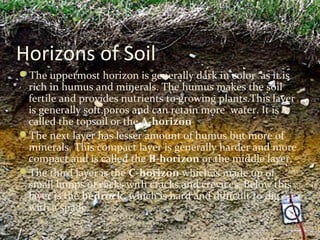Ch 9 Soil
- 2. What is soil Soil is one of the most important natural resources. It supports the growth of plants by holding the roots firmly and supplying water and nutrients. It is the home for many organisms. Soil is essential for agriculture. Agriculture provides food, clothing and shelter for all. Soil is thus an inseparable part of our life.
- 3. Layers of Soil Soil is composed of distinct layers.
- 4. Soil Profile A vertical section through different layers of soil is called the soil profile. Each layer differs in feel(texture),color, depth and chemical composition.These layers are known as horizons
- 5. Horizons of Soil The uppermost horizon is generally dark in color as it is rich in humus and minerals. The humus makes the soil fertile and provides nutrients to growing plants.This layer is generally soft,poros and can retain more water. It is called the topsoil or the A-horizon The next layer has lesser amount of humus but more of minerals. This compact layer is generally harder and more compact and is called the B-horizon or the middle layer. The third layer is the C-horizon which is made up of small lumps of rocks with cracks and crevices. Below this layer is the bedrock, which is hard and difficult to dig with a spade.
- 6. Parts of Soil As you know, wheathering of rocks produces small particles of various materials . These include sand and clay depends upon the rock from which the particles were formed, that is the present rock . The mixture of rock particles and humus is called the soil. Living organisms, such as bacteria, plant roots and earthworm are also important parts of any soil
- 7. Wheathering The soil is formed by the breaking down of rocks by the action of wind, water and climate this process is known as Wheathering
- 8. Types of Soil The soil is classified on the proportion of particles of various sizes. If soil contains greater proportion of big particles it is called sandy soil. If the proportion of fine particles is relatively higher , then it is called clayey soil. if the amount of large and fine particles is about the same, then it is called loamy soil.
- 9. Properties of Soil Percolation rate of water in soil Formulae of rate percolation is Percolation rate (ml/min) = Amount of water (ml)/Percolation time (min) Moisture in soil Soil moisture is difficult to define because it means different things in different disciplines. For example, a farmer's concept of soil moisture is different from that of a water resource manager or a weather forecaster. Generally, however, soil moisture is the water that is held in the spaces between soil particles.
- 10. Soil and Crops Different types of soils are found in different parts of India. In some parts there is clayey soil, in some parts there is loamy soil while in some other parts there is sandy soil. Soil is affected by wind, rainfall, temperature , light and humidity. These are some important climatic factors which affect the soil profile and bring changes in the soil structure.The climatic factors, as well as the components of soil, determine the various. Types of vegetation and crops that might grow in any region.
- 11. Making Pots Pottery is made by forming a clay body into objects of a required shape and heating them to high temperatures in a kiln which removes all the water from the clay, which induces reactions that lead to permanent changes including increasing their strength and hardening and setting their shape. A clay body can be decorated before or after firing. Prior to some shaping processes, clay must be prepared. Kneading helps to ensure an even moisture content throughout the body. Air trapped within the clay body needs to be removed. This is called de-airing and can be accomplished by a machine called a vacuum pug or manually by wedging. Once a clay body has been kneaded and de-aired or wedged, it is shaped by a variety of techniques. After shaping it is dried and then fired.
- 12. Soil Erosion Erosion is the process by which soil and rock are removed from the Earth's surface by exogenetic processes such as wind or water flow, and then transported and deposited in other locations. While erosion is a natural process, human activities have increased by 10-40 times the rate at which erosion is occurring globally. Excessive erosion causes problems such as desertification, decreases in agricultural productivity due to land degradation, sedimentation of waterways, and ecological collapse due to loss of the nutrient rich upper soil layers. Water and wind erosion are now the two primary causes of land degradation; combined, they are responsible for 84% of degraded acreage, making excessive erosion one of the most significant global environmental problems
- 13. How can we prevent Soil Erosion Plant grass and ground cover in huge expansive gardens and on sports fields Never leave embankments or sloped gardens bare and exposed. Ensure that homes and other buildings have adequate draining and water collection systems. Adopt a small piece of land outside your property as your own. Create a dislike for bare and open spaces around your home, schools, universities etc.
- 14. Thank you













